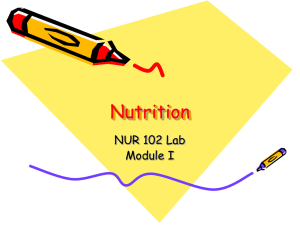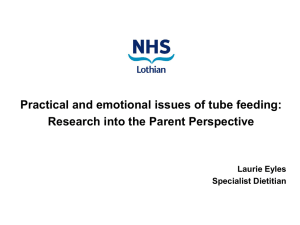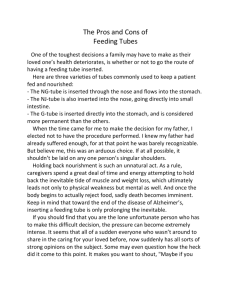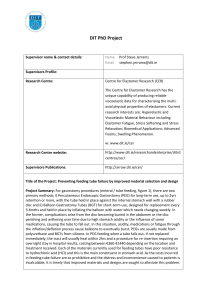How could tube feeding help me?
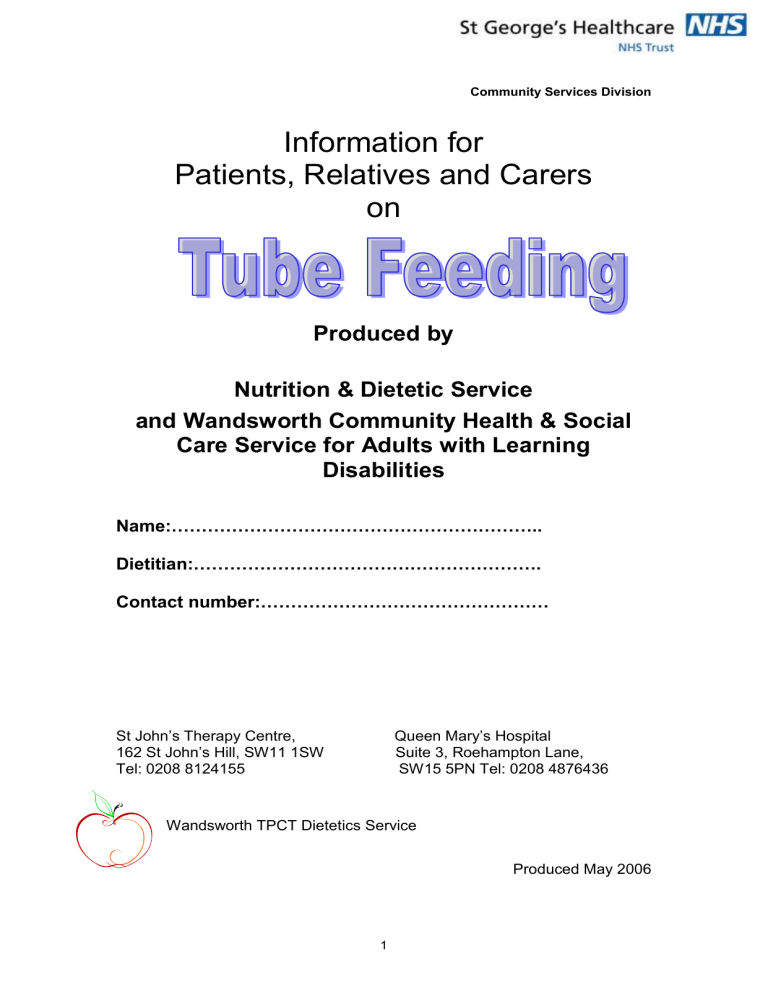
Community Services Division
Information for
Patients, Relatives and Carers on
Produced by
Nutrition & Dietetic Service and Wandsworth Community Health & Social
Care Service for Adults with Learning
Disabilities
Name:……………………………………………………..
Dietitia n:………………………………………………….
Contact number:…………………………………………
St John’s Therapy Centre, Queen Mary’s Hospital
162 St John’s Hill, SW11 1SW
Suite 3, Roehampton Lane,
Tel: 0208 8124155 SW15 5PN Tel: 0208 4876436
Wandsworth TPCT Dietetics Service
Produced May 2006
1
This leaflet has information on tube feeding. It will hopefully help you decide whether to have tube feeding or not by explaining what tube feeding is and discussing some of the advantages and disadvantages.
If, after reading this leaflet, you still have questions that have not been answered, feel free to talk to the team of health professionals involved in your care.
What is tube feeding?
Tube feeding, also called alternative or artificial feeding is a way of providing nutrition and/or fluids when you are not able to manage to take enough orally (by mouth) or safely. It is also a way that medications can be given.
There are many different reasons why someone is not able to eat and drink enough. Some of the more common reasons are:
Swallowing difficulties or deemed unsafe by a Speech and
Language Therapist (e.g. following a stroke, in progressive neurological conditions such as motor neurone disease and multiple sclerosis, or as a short- or long-term side effect of some cancer treatments)
Obstruction of the digestive tract (e.g. cancer of the oesophagus, head & neck cancers)
Increased nutritional/fluid requirements (e.g. non-healing wounds, certain metabolic conditions) that cannot be met sufficiently by the diet
How long will I need the tube for?
This will depend on your individual needs and may be either shortterm, e.g. while having a particular treatment, or long-term when the underlying cause is not reversible. The team of health professionals looking after you may be able to give you more of an idea about how long it will be required for. However, this can be very difficult to predict and may need to be reviewed on an ongoing basis. If, at any time, you and the clinical team feel that tube feeding has become more of a burden than a benefit then it can be stopped.
2
If you need the tube for a long period of time then it may need to be replaced. This is often done as a day-patient at hospital or, depending on the tube, can sometimes be done at home by the district nurse.
If you no longer need the tube it can be removed. The site will close very quickly and most people are left with only a small scar.
Making the decision
Having read this leaflet and considered some of the advantages and disadvantages of tube feeding, you now need to consider if tube feeding is right for you. As with any treatment the benefits must be weighed against the risks.
Sometimes this can be a very difficult decision to make and you may feel that you need to discuss it in further detail. The team of health professionals looking after you will be happy to talk through any issues that you, your relatives or carers may have.
Gastrostomy feeding is suitable for people who are likely to require tube feeding for a longer period of time (i.e. more than 4 weeks). A gastrostomy tube is a narrow tube that is inserted through the abdominal wall and directly into the stomach. There are different types of tubes which differ in the way that they are inserted.
3
A PEG is the most common type of gastrostomy tube. The term
PEG describes the way that it is inserted:
P ercutaneous (through the skin)
E ndoscopic (instrument used to examine the stomach)
G astrostomy (opening into the stomach)
The tube is inserted during a minor operation and is usually carried out under local anaesthetic and light sedation (medication to make you drowsy). An endoscope (a flexible instrument used to examine your stomach) is passed down into your stomach. A small incision is made in the abdominal wall and a guidewire is inserted. The tube is then attached to the guidewire and gently pulled through the incision until the internal retention device is lying against the stomach wall. The tube is then secured so that the tract (the hole between your stomach and your abdomen) can heal. The whole procedure takes about 30 minutes.
This is a picture of a commonly used PEG:
Internal retention device
(inside the stomach)
External retention device
(outside the body)
Tube with various attachments for ease of use
How would I be fed?
Your dietitian will recommend a specially prepared liquid feed which is then prescribed by your doctor. The feed can either be given by attaching a syringe to your tube (bolus feeding), several times a day, or by using an electric feeding pump (continuous feeding), which is supplied by the feed manufacturers.
When and how you have the feed will depend on your lifestyle and circumstances. You may wish to have it overnight, or you may
4
prefer to have it during the day. You may also need extra water through your tube to keep you hydrated.
As with anything new, tube feeding may change your routine and it may take time to adjust to these changes. Talk to your dietitian/home feed company nurse on how best to include tube feeding into your existing lifestyle.
What support would I have?
Training will be provided on all aspects of tube feeding. Some people manage the tube feeding themselves, while others need support from relatives, carers and healthcare professionals.
There is support provided by the feed company, who have nurses specialising in tube feeding and can be contacted between 9am –
5pm and can also visit you at home. The feed company also has a
24 hour helpline. Additionally, the community dietitian is available from Mon-Fri, 9am-5.30pm. Also there are District Nurses attached to your GP Surgery who will have been trained on all aspects of tube feeding.
What are the risks of the procedure?
Gastrostomy tube insertion requires a medical procedure and as with any procedure there are associated risks, which will vary depending on the situation. There are some risks related to sedatives, which could affect your breathing, but light sedation can reduce these risks. Also, while inserting the feeding tube, there is a small risk of internal bleeding or puncturing of the bowel.
However, you will be monitored closely during and after the procedure. To minimise these risks, you will be assessed for suitability before the procedure. The doctor placing the tube will be able to discuss this with you in more detail.
What problems might I encounter?
Problems that can occasionally occur with tube feeding include:
Infection/leakage from the site where the tube enters the body
(called the stoma).
Possible nausea, vomiting, heartburn, bloating, constipation, diarrhoea.
5
Tube blockage
Tube misplacement
You will receive training on correct hygiene methods and how to avoid these problems. Your dietitian/home feeding company nurse can advise you on how to deal with these issues if they arise.
The other main type of gastrostomy tube is a RIG which looks slightly different and differs in the way that it is inserted and cared for:
R adiologically (under X-ray guidance)
I nserted
G astrostomy (opening into the stomach)
A nasogastric tube is passed through your nose and into your stomach. Air is then put through this tube to inflate the stomach and move it into the correct position. A small incision is then made in the abdominal wall and the tube is inserted directly into the stomach. A few stitches may be used to secure the tube until the tract has healed. The nasogastic tube is then removed. This procedure takes about an hour.
This type of tube may be recommended by the medical team as an alternative to insertion of a PEG. This may be because there is an obstruction that would prevent the endoscope from reaching the stomach, or because they feel that the procedure would affect your breathing.
This is a picture of a commonly used RIG:
Tube with various attachments for ease of use
External retention device
(outside the body)
6
Internal retention device
(inside the stomach)
There are also a number of other types of tubes that may be recommended in certain situations (e.g. surgical placement of a tube, or tubes for feeding into the small intestine (called jejunal or jejunostomy feeding).
Please feel free to discuss with your dietitian or medical team the reasons why a certain type of tube has been recommended for you.
How could tube feeding help me?
There are a number of benefits to tube feeding, some of which are listed below:
Can prevent weight loss/ malnutrition and so prevent the consequences of undernutrition (such as weakness, reduced immunity, bed sores etc.)
Can promote weight gain
May help promote wound healing
Can prevent dehydration (lack of fluid)
Difficulty in swallowing can become distressing for all concerned and tube feeding may help reduce the anxiety/pressure which often accompanies meals by allowing you to get all the nutrition you need from a specially prepared liquid feed
The tube can be used to administer medications
Can minimise the risk of a chest infection if you have any swallowing problems by allowing you to limit your oral intake
Will it improve my medical condition?
Tube feeding helps to provide good nourishment and as a result you may have an improved sense of well-being as your energy levels increase. However, it is important to remember that it cannot change the progression/diagnoses of your underlying medical condition.
7
We would like to acknowledge Kingston & Richmond Dietitians for help with the production of this leaflet
For further information,contact the support group PINNT
(Patients on Intravenous & Nasogastric Nutrition Therapy)
Website: www.pinnt.co.uk
E-mail: pinnt@dial.pipex.com
Tel. no: 01202 481 625
8

